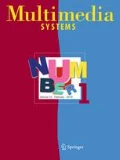Abstract
It is a fact, that we are surrounded by more and more ubiquitous services in entertainment computation. All sorts of devices are more and more connected, and personalization becomes more and more a major issue. We are living in a world with two layers: the real physical layer being our real-world, and its synthetic overlay consisting of location-based services, chatting applications, or Web 2.0 offers. In the real-world, communication between humans is a matter of personality of different persons: exchanging information about each other, finding common interests, or finding common conversation themes. In the synthetic overlay, communication becomes a matter of distribution of personal profiles or automating profile matching. The open-source platform Portable Personality (P2) (www.portable-personality.org) faces this challenge, and provides a platform for cross-service interchange of personal context information based on any generic metadata type. P2’s software architecture is designed for mining, enriching, and exchanging personal profiles between arbitrary multimedia services. The long-term vision of P2 is to provide a personality profile rather than a personal context information profile to enable communication between human and device as a matter of personalities, rather than automated matching of profiles. Two different scenarios, the Smart Social Network (SSN), and the personalization of audio-visual data are presented as practical use-case for P2.
Access this article
We’re sorry, something doesn't seem to be working properly.
Please try refreshing the page. If that doesn't work, please contact support so we can address the problem.
Similar content being viewed by others
References
Adobe Extensible Metadata Platform (XMP): http://www.adobe.com/products/xmp/main.html
Ambady N., Rosenthal R.: Thin slices of expressive behaviour as predictors of interpersonal consequences: a meta-analysis. Psychol. Bull. 111, 256–274 (1992). doi:10.1037/0033-2909.111.2.256
Boda, P., Chande, S., Gupta, N., Hartikainen, E., Autere, S.: Flexibility and efficiency through personalisation? Experiments with a conversational Program Guide Information System. In: EACL-03 Workshop on “Dialogue Systems: interaction, adaptation and styles of management”. Budapest, Hungary (2003)
Bruns, V., Reymann, S., Lugmayr, A.: Distributed profiling in a partitioned ambient network. In: Proceedings of the 6th international conference on Mobile and ubiquitous multimedia Oulu. ACM, Finland (2007)
DCMI: Dublin Core Metadata Initiative (DCMI). http://dublincore.org/
Description of a Career (DOAC). http://ramonantonio.net/doac/
Ehrmantraut, M., Haerder, T., Witting, H., Steinmetz, R.: The personal electronic program guide—towards the pre-selection of individual TV programs. In: ACM (1996)
Hossain, M.A., Atrey, P.K., El Saddik, A.: Management of ambient media preferences in distributed environments for service personalization. In: International Symposium on Parallel Architectures, Algorithms, and Networks (I-SPAN 2008) (2008)
International Press Telecommunications Council (IPTC): http://www.iptc.org/IPTC4XMP/
ISTAG: Scenarios for Ambient Intelligence in 2010—Final Report (Feb. 2001), http://www.cordis.lu/ist/istag.htm (2001)
ISTAG.: Ambient intelligence: from vision to reality. European Union: IST Advisory Group, draft report (2003)
Lehikoinen J., Aaltonen A., Huuskonen P., Salminen I.: Personal content experience: managing digital life in the mobile age. Wiley-Interscience, New York (2007)
Leslie, G.S.: Why and how CARPE should be personal? In: Proceedings of the 2nd ACM workshop on Continuous archival and retrieval of personal experiences Hilton. ACM Press, Singapore (2005)
Liberty Alliance: http://www.projectliberty.org/
Mackiewicz, J., Moeller, R.: Why people perceive typefaces to have different personalities, p. 304 (2004)
Mateas, M., Stern, A.: A behavior language for story-based believable agents. Intell. Syst. IEEE 17, 39 (2002). see also IEEE Intelligent Systems and Their Applications. doi:10.1109/MIS.2002.1024751
McCluskey, E., Mahmood, A., Lu, D.: Concurrent fault detection using a watchdog prozessor and assertions. In: Proceedings of the IEEE International Test Conference Philadelphia (1983)
Open, I.D.: http://openid.net/
Ören, T.I., Ghasem-Aghaee, N.: Personality representation processable in fuzzy logic for human behavior simulation. In: Summer Computer Simulation Conference, pp. 11–18. Montreal, PQ, Canada (2003)
Reis, H.T., Collins, W.A., Berscheid, E.: The relationship context of human behavior and development. Psychol. Bull. 126, 844–872 (2000). <Go to ISI>://000165365200004
Reymann, S., Kemper, S.: AMBINET—a lightweight development framework for ambient application design. In: NAMU Lab. vol. MSc. Tampere: Tampere University of Technology (TUT) (2008)
Reymann, S., Bruns, V., Lugmayr, A.: P2—Portable personality a middleware solution for smart user profile management and distribution. In: Interactive TV: A Shared Experience, TISCP Adjunct Proceedings of EuroITV 2007 Amsterdam, (2007)
Reymann, S., Kemper, S., Lugmayr, A.: AmbiNet—a lightweight open source development framework for personalized ambient entertainment. In: Lugmayr, A., Kemper, S., Obrist, M., Mirlacher, T., Tscheligi, M. (eds.) Changing Television Environments, TICSP Adjunct Proceedings of EuroITV, vol. 42. Tampere University of Technology (TUT), Salzburg, Austria (2008)
Riva, G., Vatalaro, F., Davide, F., Alcaniz, M.: Ambient Intelligence. IOS Press (2005). http://ambientintelligence.org
SchemaWeb: http://www.schemaweb.info/default.aspx
SyncML, Building an Industy-Wide Mobile Data Syncronization Protocol: Version 1.0
The Friend of a Friend (FOAF) Project: http://www.foaf-project.org/
Tseng B.L., Lin C.-Y., Smith J.R.: Using MPEG-7 and MPEG-21 for personalizing video. Multimedia IEEE 11, 42–52 (2004). doi:10.1109/MMUL.2004.1261105
Uhlmann, S., Lugmayr, A.: Personalization algorithms for portable personality. In: Proceedings of the 12th international conference on Entertainment and media in the ubiquitous era Tampere. ACM, Finland (2008)
W3C: World Wide Web Consortium (W3C). www.w3c.org
W3C Multimedia Semantics Incubator Group. http://www.w3.org/2005/Incubator/mmsem/
World Wide Web Consortium (W3C): XML Schema Part 2: Datatypes (2001)
World Wide Web Consortium (W3C): XML Schema Part 1: Structures (2001)
World Wide Web Consortium (W3C): XML Schema Part 0: Primer (2001)
WWI Ambient Networks Project 507134.: D.1.5 AN Framework Architecture—Mobile and Wireless Systems beyond 3G. 6th Framework Programme
Author information
Authors and Affiliations
Corresponding author
Rights and permissions
About this article
Cite this article
Lugmayr, A., Reymann, S., Bruns, V. et al. Distributing the personal digital environment throughout your entertainment environment: handling personal metadata across domains. Multimedia Systems 15, 187–199 (2009). https://doi.org/10.1007/s00530-009-0162-4
Published:
Issue Date:
DOI: https://doi.org/10.1007/s00530-009-0162-4




